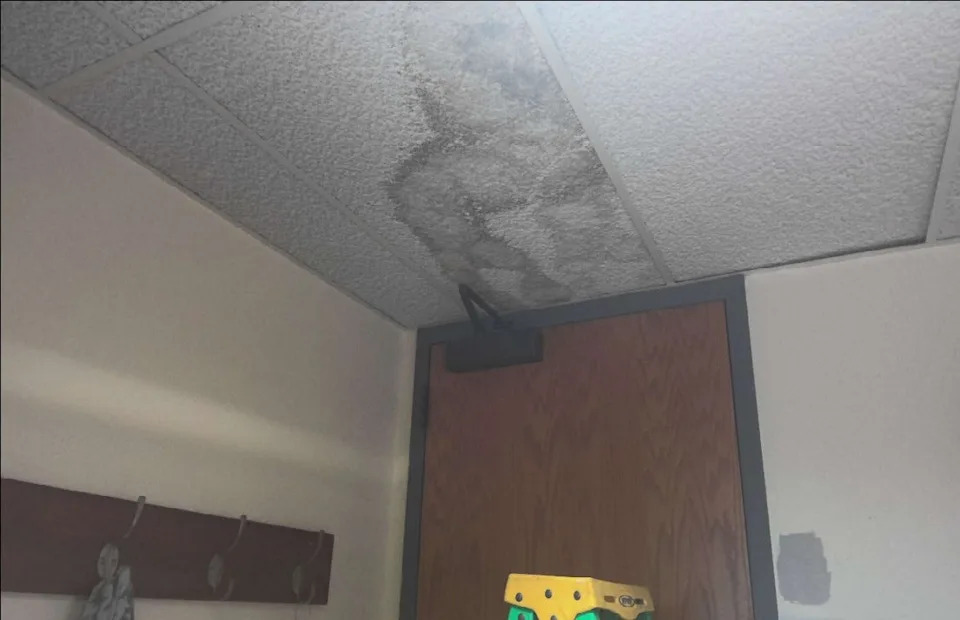From ‘fuzzy” growth on ceiling tiles to suspected mold and mildew dripping onto desks, county employees say deteriorating conditions in the 40-year-old justice center are making them sick, and one of them has filed a complaint with a state agency.
The Indiana Occupational Safety and Health Administration, part of the state’s department of labor, sent county officials a letter on Tuesday, informing them the agency had received a complaint “concerning mold or fungi” in the Charlotte Zietlow Justice Center, 301 N. College Ave.

“The hazard consists of condensation, mold and mildew in the upper levels of the building that seeps down through the ceiling and drips onto the desks and workspaces within my office,” the letter read. “To the best of my knowledge, the entire 2nd floor of the Justice Building is affected which includes approximately 36 employees.”
The second floor of the justice center houses, among others, the offices of Monroe County Clerk Nicole Browne and Prosecutor Erika Oliphant. The third floor provides space for courtrooms. Upper floors hold jail inmates.
IOSHA requested that the county “investigate the alleged conditions and make any necessary corrections or modifications to minimize the growth of mold.” The agency said it was “not planning to conduct an inspection at this time.”
Employees who work in the building said Thursday that occasional moisture damage has plagued the building for a long time and, given the structure’s age, was not particularly surprising. However, Oliphant, the prosecutor, said the problem appears to have gotten worse recently and was fueled, perhaps, by this year’s hot, wet summer.
Angie Purdie, the commissioners' administrator, said via email, "This issue is the direct result of the recent high temperatures and humidity experienced by our community coupled with an old building. Condensation was forming on duct work, falling into, and penetrating the ceiling panels, and the ability to maintain an equitable heating/cooling environment was a losing battle."
Oliphant said she started getting a black spot on a ceiling tile in her office this summer, but recently, “It started actively becoming fuzzy and moldy.”
The prosecutor said she deals with allergies and often does not feel good when she is in the office. She brought in a mold detection kit that tested positive and alerted county officials, who had the tile removed and replaced.
However, this week, some of her staff also complained about health effects, which prompted Oliphant to contact the county’s human resources office. She was notified by the county commissioner’s office that they were going to do mold testing, which was completed Wednesday, with results pending.
Oliphant said she did not file the IOSHA complaint and commended county commissioners for their prompt response to the problem. The commissioners’ office provided a copy of the complaint but commissioners could not be reached immediately to comment on the matter.
Bloomington-based VET Environmental Engineering this month already had conducted mold testing on the building’s third floor after workers near damaged ceiling tiles reported “adverse health conditions.”

Sara Hamidovic, the company’s president, CEO and principal engineer, wrote she found mold on surfaces on the building’s third floor.
“One indoor air sample also exhibited ‘Elevated’ levels of airborne Aspergillus/Pencillium spores, however total fungi levels for all indoor air samples were reported as ‘Acceptable.’
According to the CDC, most people do not get sick from Aspergillus, a common mold, although it can cause mild to severe illness in certain populations such as people with weakened immune systems or lung diseases.
Hamidovic recommended the county clean “active mold growth on building material on the third floor” and, out of an abundance of caution, implement remedial measures “to address possible development of problematic airborne mold conditions.”
She said the county also should implement humidity controls to ensure relative humidity remains at or below 50%. Relative humidity levels in most parts of the building were at the high end of the range recommended by the U.S. Environmental Protection Agency — below 60% — though the agency recommends that humidity ideally be between 30% and 50% to discourage mold growth.
The report by Hamidovic includes photos of a discolored — and since removed — ceiling tile in the office of Monroe Circuit Judge Holly Harvey and a "gray substance forming on ... concrete blocks; arranged in a splatter pattern;" in the building's north stairway.
Purdie said the county "is still in the information gathering stage ... and VET has agreed to meet with staff and elected officials next Thursday to discuss the findings, hear concerns, and explain the remediation process."
She also said the county has bought commercial de-humidifiers to help address the problems.
The worsening condition of the justice center is arriving at an especially inopportune time for county leaders, as the state has cut local governments’ property tax revenue and implemented a moratorium on borrowing more money, which the county desperately needs to fund its long-delayed $225-million new jail/criminal justice complex. A federal lawsuit the ACLU filed in 2008 — because of overcrowding and deteriorating conditions — has required the county to upgrade or replace the current jail.
Oliphant said she worries county leaders will build a new structure to house the justice center’s jail — but will leave the offices and courtrooms where they are.
“I truly don't believe that it’s going to be physically responsible to try to rehabilitate this building at this point,” she said. “I think there's so much going on. They're constantly chasing their tail to try to figure out what is the root cause of problems in the building, and it's just fallen apart.”
Oliphant said while she understands some of the constraints within which county leaders are operating, “I just think they’re at a point where there just aren’t a lot of options to save this building.”
County Council member David Henry said while he did not yet know the full extent of the recent problems, “occupant safety comes first.”
“Sadly I think this is another case of an ounce of prevention being worth a pound of cure,” Henry said via text message. “We have to make some hard correct choices over easy wrong ones in the budget we have, now.”
Purdie said, "Regarding the issue of putting money into an aging building ... no one likes that, but until there is another space, the commissioners have a responsibility to provide a work environment that is conducive to health, comfort, and productivity.
"The Council is responsible for ensuring the commissioners have the necessary appropriations to meet those needs," she said.
Henry also said county leaders must focus on all aspects of the justice system — not just the jail building — if they want to operate a system with long-term viability in mind.
“We simply have to plan better for the end of life of the building while pursuing realistic restorative justice, trial rule reform, alternatives, and mental health that keeps the jail population sustainable and finding a facility that is safe and doesn’t break the county’s wallet,” he said.
Boris Ladwig can be reached at [email protected].
This article originally appeared on The Herald-Times: Health concerns over Monroe justice center mold prompt OSHA complaint








Comments